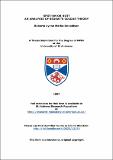Files in this item
Spot-on or not? : an analysis of Seurat's colour theory
Item metadata
| dc.contributor.advisor | Kemp, Martin | |
| dc.contributor.author | Marks-Donaldson, Roberta Lynne | |
| dc.coverage.spatial | 413 p., [52] p. of plates | en_US |
| dc.date.accessioned | 2017-11-27T10:52:08Z | |
| dc.date.available | 2017-11-27T10:52:08Z | |
| dc.date.issued | 1997 | |
| dc.identifier.uri | https://hdl.handle.net/10023/12174 | |
| dc.description.abstract | An analysis of mid- to late-nineteenth century scientific colour theories sets the stage for the introduction of the artistic style of French painter Georges Seurat. His traditional beaux-arts training, extraordinary skills as a draughtsman, and keen interest in the then existing science theories on colour combined in his person to create a new approach called Divisionism, (also called Pointillisme, pointillism, and melange optique). As Seurat's readings of scientific literature and his practical applications of the theories to his artistic style became refined, a new movement called Neo-Impressionism developed around him and through his example. Amidst both critical acclaim and scorn, Seurat proceeded with great determination from his novel drawing style to a refinement of his approach to colour. An untimely death ended the research of this singular artist just years before scientific findings were published which would have forced Seurat into a different approach. An intensive look at Seurat's theories and key pieces is considered in terms of his objectives: A major point is whether what we now consider to be Seurat's theory was really what he had in mind; have our present perceptions distorted his original intentions? The materials Seurat had at hand, the chemical composition of the pigments and the effects of time, grime and light are discussed as to their impacts on achieving his goals. An in-depth comparison of late twentieth-century colour research in perception via psychological, neurophysiological and artistic/emotional routes point out the strengths and weaknesses of Seurat's approach and explains what really happens in the visual process, as far as it is understood today. Scientific colour theories and artistic colour approaches can form a redoubtable partnership but could they ever have become one to exist in the optical mixture we believe Seurat had so wished to elicit? | en_US |
| dc.language.iso | en | en_US |
| dc.publisher | University of St Andrews | |
| dc.subject.lcc | ND553.S4M2 | |
| dc.subject.lcsh | Seurat, Georges,|d1859-1891 | |
| dc.title | Spot-on or not? : an analysis of Seurat's colour theory | en_US |
| dc.type | Thesis | en_US |
| dc.contributor.sponsor | Rotary International | en_US |
| dc.contributor.sponsor | Gilchrist Foundation | en_US |
| dc.contributor.sponsor | University of St Andrews | en_US |
| dc.contributor.sponsor | British Federation of University Women. Edinburgh Branch | en_US |
| dc.contributor.sponsor | Russell Trust | en_US |
| dc.contributor.sponsor | Richard Gapper Bequest | en_US |
| dc.type.qualificationlevel | Doctoral | en_US |
| dc.type.qualificationname | MPhil Master of Philosophy | en_US |
| dc.publisher.institution | The University of St Andrews | en_US |
This item appears in the following Collection(s)
Items in the St Andrews Research Repository are protected by copyright, with all rights reserved, unless otherwise indicated.

